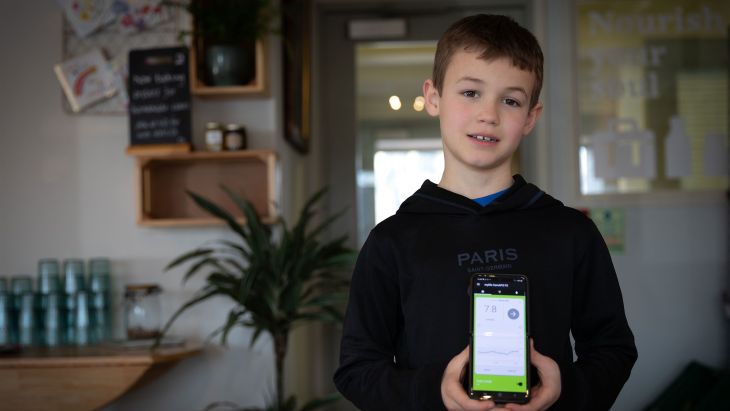The National Institute for Health and Care Excellence (NICE) has today (7 November 2023) recommended hybrid closed loop systems, including the CamAPS FX app, for use in managing type 1 diabetes, meaning that even more people living with the disease will be able to use this life-changing app.
“CamAPS has been a godsend,” says Ian Haigh, father to nine-year-old Eddie who has type 1 diabetes. Eddie uses the app to help him manage his diabetes – it’s meant an end to the relentless cycle of finger-pricking, injections and sleepless nights. Thanks to the CamAPS FX app Eddie can now learn without interruption, spend time with his friends and play sport.
Eddie and Ian Haigh
Eddie and Ian Haigh
Eddie was diagnosed with type 1 diabetes when he was three years old. “We were in Norfolk on holiday,” says Eddie, “and I was drinking a lot of water and going to the toilet a bunch of times.”
Sensing something might be wrong, Ian took Eddie to the GP who sent them urgently to hospital. Within 20 minutes they were in A&E. Tests showed that Eddie had hyperglycaemia – dangerously high blood sugar levels. The next few days were spent on the ward. While the doctors worked to stabilise Eddie, Ian and his wife Sarah were given a crash-course in managing type 1 diabetes.
“Diabetes is overwhelming, you have to be on top of it constantly,” says Ian. “We were injecting Eddie with insulin eight or nine times a day – every time he wanted to eat or was getting too high.” A further injection was given overnight to keep Eddie stable, all administered with an insulin pen.
On top of the injections were the finger skin pricks to assess glucose levels and calculate the insulin needed. Eddie worked out that he used to have around 15 a day totalling over 3,000 a year. Ian remembers how sore Eddie’s fingers became.
“It was exhausting. During the night we’d be up four or five times just checking him,” says Ian. If Eddie’s glucose levels were too high or low, Ian or Sarah could be up for several hours as they waited for the insulin to stabilise his blood sugar. And then in the morning there was work or school to go to.
Eddie remembers having to leave class to go to the school office to have his injections and sitting out of PE – one of his favourite lessons – if his glucose levels were too low. Play dates, sleepovers and school trips were almost impossible.
But three-and-a-half years after Eddie’s diagnosis, a call out of the blue – an invitation to take part in a study to trial a new app called the CamAPS FX – would change everything. It was 2020 and the country was in lockdown. Ian was furloughed from his job in hospitality “attempting” to home-school Eddie and older son, Henry.
“It was Eddie's decision of course,” says Ian, who explains that despite Eddie feeling apprehensive at first, he decided to give it a go after meeting the clinicians running the study.
“It’s been unbelievable, life-changing,” says Ian. “We’re so lucky to have CamAPS. It’s not an ideal situation that Eddie’s got type 1 diabetes but now the management is so much easier.”
Phone showing CamAPS FX
Phone showing CamAPS FX
The CamAPS FX app works by taking a measurement of Eddie’s glucose levels, via a sensor that he wears, every five minutes. This information is fed back into the app which uses an algorithm to calculate how much insulin is needed. This data is then sent to an insulin pump, that dispenses the correct amount of insulin. Over time the app learns more about Eddie’s diabetes and lifestyle meaning the algorithm becomes increasingly fine-tuned to his needs.
When Eddie eats, he lets the app know how much carbohydrate he’s eating. The app then calculates the insulin needed which Eddie can release with a touch.
“Giving insulin is ten-times quicker than using the insulin pens as I just press the knife and fork button on the app,” says Eddie, “and I hardly ever need finger pricks.”
“It’s all done by the phone which is just incredible”, says Ian.
Having the app on a mobile phone means that Eddie can keep an eye on his glucose levels easily. Ian and Sarah can also access CamAPS on their phones too which helps to give them peace of mind if they’re not with Eddie. The app also sends an alert when his glucose levels are too high or low meaning that the family can finally sleep through the night knowing that if there’s a problem the app will wake them up.
Eddie Haigh
Eddie Haigh
Almost three years have passed since the initial study. These days Eddie takes the lead in managing his diabetes. He’s even been involved in improving the app and through the trial has met other children with diabetes – helping him to feel like he’s not the only one with the disease. As for Ian, after many years of working in hospitality, and buoyed by the extra hours of sleep, he took the plunge and opened his own café. “Business is good,” he says.
Ian says the app has “given us more freedom”. The whole family is feeling the benefit and Eddie especially is flourishing.
“Now I don’t need to leave class or go to the office at lunchtime,” says Eddie. “I can go to friends’ houses, have sleepovers and play football.”
















